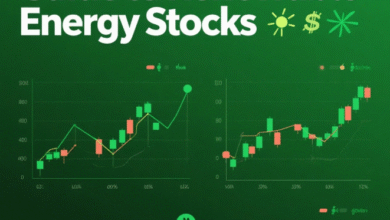Industry Sector Performance: Key Trends, Analysis, and Insights for Smarter Investment Strategies
Advertisement
When I look at the economy, I see a landscape that’s always shifting. Some industries surge ahead while others face unexpected challenges. Understanding these changes isn’t just interesting—it’s essential for anyone who wants to make informed business or investment decisions.
I’ve noticed that tracking industry sector performance gives me a clearer picture of where opportunities and risks lie. It helps me spot trends before they hit the headlines and adjust my strategies to stay ahead of the curve. Whether you’re a business owner, investor, or just curious about the market, keeping an eye on sector performance can make all the difference.
Overview of Industry Sector Performance
Industry sector performance tracks how different market categories—such as finance, technology, healthcare, and consumer goods—report profits, losses, and growth over specified time frames. I use quarterly reports, stock indices, and industry-specific benchmarks to evaluate the output of each sector. Economic cycles directly impact sector strength; for example, during high-inflation years like 2022, energy and commodities outperformed while technology struggled.
Geographical context also shapes industry trends. North American tech sectors typically lead global growth, while Asian manufacturing posts higher export volumes. Shifts in government policy, such as changes to regulation or tax incentives, quickly alter sector rankings. Major global events, such as public health crises or international conflicts, produce rapid shifts in the relative performance of sectors.
I monitor these metrics to identify trends, outliers, and evolving patterns across sectors. Tracking sector performance lets me pinpoint industries with above-average returns or groups facing ongoing contraction. This comparative analysis supports sector rotation strategies, risk management, and long-term planning.
Key Factors Influencing Industry Sector Performance

I analyze sector performance using several core variables that determine momentum, competitiveness, and resilience. These factors connect directly to market outcomes and long-term strategic positioning.
Economic Trends and Market Conditions
I assess macroeconomic indicators—such as GDP growth, inflation rates, and unemployment levels—to gauge sector outlook. For example, rising interest rates in 2023 led to underperformance in REITs and consumer discretionary stocks, according to S&P Global. Exchange rates affect export-driven sectors, while commodity price swings directly impact the margins of the energy and agriculture sectors. Market cycles, such as recessions or expansions, consistently shift sector leadership and risk exposure.
Technological Innovations
I track the adoption of disruptive technologies—such as artificial intelligence, automation, and digital platforms—since these transform sector output, efficiency, and demand patterns. For instance, AI integration propelled semiconductor and software firms ahead of traditional telecommunications companies during 2023 (McKinsey Global Institute). High R&D investment rates drive sector differentiation, particularly in the pharmaceutical and IT sectors.
Regulatory Environment
I monitor legislative and policy shifts impacting sector risk profiles. Regulatory changes—such as environmental standards, data privacy laws, and trade tariffs—alter cost structures and market reach. For example, EU emissions rules raised automotive manufacturing costs, while US health reforms shaped insurance sector profitability (OECD). Sectors highly regulated by governments, such as finance and healthcare, exhibit greater sensitivity to policy updates.
Comparative Analysis of Major Industry Sectors
Evaluating industry sector performance provides me with clarity on the underlying trends, strengths, and challenges that shape market leadership. Below, I offer comparative insights into the manufacturing, technology, healthcare, and energy sectors, utilizing recent benchmarks and operational data.
Manufacturing
Manufacturing output reflects global supply chain resilience and cost factors. I see consistent expansion in Asian manufacturing, led by China and South Korea, with export volumes rising over 4% in 2023, according to UNCTAD. US manufacturing exhibits stable growth in aerospace and industrial equipment, but shows weakness in textiles and basic metals, largely due to high energy prices and labor shortages. Regulatory shifts, especially emissions standards in Europe, affect operational expenses and drive investment in energy efficiency technology.
Technology
The technology sector’s performance centers on innovation, scalability, and consumer adoption. US technology companies, such as those in the S&P 500 Information Technology Index, reported an average 13% growth in Q4 2023 revenues, fueled by the expansion of AI, cloud computing, and cybersecurity (Statista, 2024). Asian tech companies continue to maintain their strength in semiconductor fabrication, with Taiwan and South Korea contributing nearly 70% of global chip exports (WSTS, 2023). Sector risks stem from regulatory scrutiny and fluctuations in consumer electronics demand.
Healthcare
The healthcare sector’s growth remains resilient due to demographic trends and sustained demand for medical innovation. I track 6% annualized growth in US healthcare revenues in 2023, driven by increased pharmaceutical sales, the adoption of digital health platforms, and pandemic-related tailwinds (KFF, 2024). European healthcare focuses on R&D investment, particularly in biotechnology, while emerging markets prioritize access and affordability, creating contrasting regional paths for sector expansion.
Energy
The energy sector’s returns fluctuate with commodity prices and policy changes. Oil and gas producers, such as those tracked in the MSCI World Energy Index, reported an average profit margin gain of 22% in 2022, coinciding with a surge in crude prices (IEA, 2023). Renewable energy investment surged by 17% globally in 2023, led by solar and wind projects in the EU and China (IRENA, 2024). Sector performance depends on policy frameworks, carbon pricing, and technological advances in storage and grid integration.
Recent Trends Shaping Industry Sector Performance
Supply chain disruptions drive shifts in industry sector performance, with manufacturing, consumer electronics, and automotive examples facing delays and cost increases since 2021. Digital transformation accelerates sector realignment, as exemplified by the expansion of cloud adoption and automation in financial services, healthcare, and retail, leading to higher productivity. ESG (environmental, social, and governance) criteria are gaining importance, prompting energy, consumer staples, and industrials companies to adjust their strategies to meet investor demand and regulatory mandates.
Labor market fluctuations impact industry momentum, with examples in technology and logistics experiencing talent shortages that slow growth and drive up wages. Regional instability and geopolitical conflicts have led to volatility in the performance of the energy and defense sectors, as evidenced by commodity price surges and shifting export patterns since early 2022. AI investment drives performance in semiconductor, software, and communications sectors, as large firms adopt generative AI and language model applications at scale.
Interest rate changes significantly impact capital-intensive industry sectors, with real estate, utilities, and infrastructure sectors providing examples of valuation swings tied to central bank monetary policy since 2022. Consumer behavior is altering sector dynamics, as remote work and online shopping continue to shift office, transportation, and brick-and-mortar retail examples in favor of software, e-commerce, and logistics players. Mergers and acquisitions activity increases, particularly in the pharmaceuticals, technology, and telecommunications sectors, as firms consolidate to compete in increasingly crowded markets.
Challenges and Opportunities for Industry Sectors
Economic Uncertainty
Industry sector performance fluctuates in response to economic uncertainty, which is driven by factors such as inflation, shifting interest rates, and global crises. I see energy and commodities capitalizing on price spikes during inflationary periods, while consumer discretionary and technology sectors typically contract under rising borrowing costs.
Regulatory Shifts
Regulatory changes introduce challenges and opportunities simultaneously for multiple sectors. I track healthcare as it adjusts to evolving reimbursement models, manufacturing responds to new emissions standards, and financials face stricter compliance obligations. Expanded regulations often raise operational costs while opening new service markets for agile players.
Technological Innovation
Technological advances continue to transform sector dynamics, with automation, AI, and digitization enabling the technology, communications, and healthcare industries to outperform. I note that rapid adoption creates a competitive edge. Still, sectors that are slow to adapt, such as traditional retail or utilities, face margin pressures and a loss of market share.
Geopolitical Tensions
Geopolitical risks disrupt global industries through trade sanctions, supply restrictions, and volatility in key commodities. I observe that the defense, energy, and agricultural sectors are benefiting from regional tensions, while exporters in the consumer goods and automotive sectors often encounter logistical bottlenecks and demand shocks.
ESG Requirements
ESG (environmental, social, governance) considerations present cross-sector challenges as businesses incorporate more sustainable operations to comply with regulations and satisfy investor preferences. The energy and industrial sectors are investing heavily in renewables, while financial firms are introducing green financing products to capture emerging capital flows.
Talent Management
Talent shortages create obstacles and opportunities in high-growth sectors. I see technology, logistics, and healthcare struggling to fill skilled roles, driving wage growth and higher recruitment costs. Conversely, industries that adopt flexible and remote work environments gain access to a broader talent pool.
Consumer Behavior Shifts
Changing consumer behavior drives sector momentum, with industries such as e-commerce, cloud services, and remote collaboration technologies benefiting from the widespread adoption of digital lifestyles. I notice that hospitality, entertainment, and commercial real estate are adapting their business models to capture hybrid demand as work and retail trends evolve.
| Challenge/Opportunity | Impacted Sectors | Example |
|---|---|---|
| Economic Uncertainty | Energy, Tech, Consumer Discretionary | Inflation boosts commodities |
| Regulatory Shifts | Healthcare, Manufacturing, Finance | New emissions rules affect the auto industry |
| Technological Innovation | Tech, Communications, Healthcare | AI in diagnostics |
| Geopolitical Tensions | Defense, Energy, Automotive | Sanctions disrupt supply chains |
| ESG Requirements | Energy, Industrials, Finance | Renewable investments |
| Talent Management | Technology, Logistics, Healthcare | Wage hikes in tech jobs |
| Consumer Behavior Shifts | E-commerce, Real Estate, Retail | Online shopping surge |
Conclusion
Staying ahead in today’s evolving market means keeping a close eye on industry sector performance. Understanding the forces driving each sector helps me make more informed decisions and identify emerging opportunities before they become mainstream.
By regularly tracking trends and adapting my strategy, I’m better equipped to navigate uncertainty and capitalize on shifts in the economic landscape. This approach not only supports growth but also strengthens my resilience in a rapidly changing world.
Frequently Asked Questions
What is industry sector performance, and why does it matter?
Industry sector performance refers to the performance of various business categories, such as technology, healthcare, or energy, in terms of profits, growth, or losses. Tracking these trends enables investors, business owners, and market watchers to make informed decisions based on which sectors are thriving or facing challenges.
How are industry sectors measured and evaluated for comparison?
Industry sectors are measured using tools like quarterly reports, stock market indices, and industry-specific benchmarks. Sectors are compared based on financial results, growth rates, and their responses to economic cycles, such as periods of high inflation or recession.
Which factors influence industry sector performance the most?
Key factors include macroeconomic indicators like GDP growth, inflation, and unemployment, as well as interest rates and government policies. Other important influences are technological innovation, supply chain conditions, regulatory changes, and global events or geopolitical tensions.
Why do some industries perform better during certain economic conditions?
Different industries have unique strengths and vulnerabilities. For example, energy tends to do well during times of inflation, while technology may struggle. Sector performance often fluctuates with changes in interest rates, consumer demand, and supply chain stability.
How do geographical regions affect sector performance?
Geography matters because different regions specialize in various industries. North America leads in technology, while Asia excels in manufacturing. Policy and economic differences can also favor certain sectors in their respective countries or continents.
What recent trends are most impacting sectors today?
Recent key trends include global supply chain disruptions, rapid digital transformation, increased focus on ESG (environmental, social, and governance) factors, labor shortages, and geopolitical conflicts. These trends continue to create winners and losers among industries.
How does technological innovation impact industry sectors?
Technological advancements, such as artificial intelligence (AI) and automation, can significantly enhance productivity and efficiency. Sectors embracing innovation—such as technology, healthcare, and communications—often experience stronger growth compared to those that are slower to adapt.
What is sector rotation, and why is it important?
Sector rotation is the practice of reallocating investments across different industries as economic conditions shift. It helps investors manage risk and capitalize on opportunities by focusing on sectors that are likely to perform best in the current market cycle.
How do regulatory changes influence industry performance?
Regulatory shifts can change costs, access to markets, or operational requirements. For instance, new healthcare laws can impact medical companies, while energy and automotive firms are affected by environmental regulations.
What opportunities and risks are currently prominent for industries?
Opportunities lie in the adoption of technology, ESG investing, demand for medical innovation, and renewable energy. Risks include economic uncertainty, regulatory changes, labor shortages, supply chain disruptions, and geopolitical tensions that are reshaping global industry dynamics.










